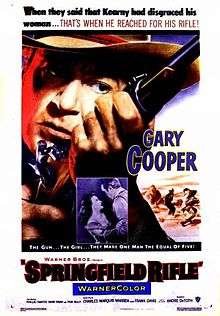Springfield Rifle (film)
| Springfield Rifle | |
|---|---|
 | |
| Directed by | Andre DeToth |
| Produced by | Louis F. Edelman |
| Written by |
Frank Davis Sloan Nibley (story) |
| Starring | Gary Cooper |
| Music by | Max Steiner |
| Cinematography | Edwin B. DuPar |
| Edited by | Robert L. Swanson |
| Distributed by | Warner Bros. Pictures |
Release dates |
|
Running time | 93 minutes |
| Country | United States |
| Language | English |
| Box office | $4.9 million (US rentals)[1] |
Springfield Rifle is a western film, directed by Andre DeToth and released by Warner Bros. Pictures in 1952.[2] The film is set during the American Civil War and stars Gary Cooper, with Phyllis Thaxter and Lon Chaney Jr..
It is described as "essentially an espionage thriller that pits a Union intelligence officer (Gary Cooper) against a Confederate spy ring."[3]
Plot
Charged with wartime cowardice, Major Lex Kearney is drummed out of the Union Army with a dishonorable discharge. His disgrace is complete, wife Erin even informing him that their ashamed son has run away. What no one knows is that Kearney has accepted a fake discharge so he can carry out a top-secret assignment to go undercover and find the rustlers who have been providing horses to Confederate troops.
Cast
- Gary Cooper as Major Lex Kearney
- Phyllis Thaxter as Erin
- David Brian as Austin McCool
- Paul Kelly as Lt. Col John Hudson
- Lon Chaney, Jr. as Pete Elm
- Philip Carey as Capt. Tennick
- Fess Parker as Confederate Sergeant Jim Randolph
Reception
The film was not well received by critics. Jeffrey Meyers noted that Cooper's career went down hill in the early 1950s, until High Noon opened in 1952, and labelled Springfield Rifle a "mediocre" western.[4]
Rebecca Fish Ewan called the film "confusing" and said that Cooper looked "ever perplexed".[5] New York Magazine said "even Cooper can't keep this film from being just another ho- hum Western."[6]
However, New York Life described it as an "exciting military melodrama of espionage and counterespionage in a frontier fort."[7]
References
- ↑ 'The Top Box Office Hits of 1953', Variety, January 13, 1954 and 'Top Box-Office Hits of 1952', Variety, January 7, 1953
- ↑ Peter Lev (2006). The Fifties: Transforming the Screen 1950-1959. University of California Press. p. 113. ISBN 978-0-520-24966-0. Retrieved April 24, 2013.
- ↑ Loukides, Paul; Fuller, Linda K. (1993). Beyond the Stars III: The Material World in American Popular Film. Popular Press. p. 167. ISBN 978-0-87972-623-2. Retrieved April 24, 2013.
- ↑ Meyers, Jeffrey (March 1, 2001). Gary Cooper: American Hero. Rowman & Littlefield. p. 253. ISBN 978-0-8154-1140-6. Retrieved April 24, 2013.
- ↑ Ewan, Rebecca Fish (November 3, 2000). A Land Between: Owens Valley, California. JHU Press. p. 215. ISBN 978-0-8018-6461-2. Retrieved April 24, 2013.
- ↑ New York Magazine. New York Media, LLC. June 9, 1986. p. 177. ISSN 0028-7369. Retrieved April 24, 2013.
- ↑ Cue: The Weekly Magazine of New York Life. Cue Publishing Company. January 1962. p. 48. Retrieved April 24, 2013.
External links
- Springfield Rifle at the American Film Institute Catalog
- Springfield Rifle at the Internet Movie Database